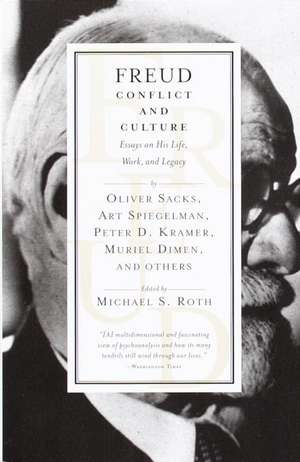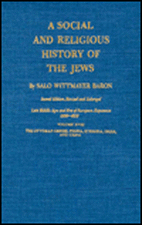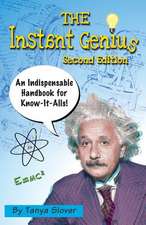Freud: Essays on His Life, Work, and Legacy
Autor Michael S. Roth Editat de Michael Rothen Limba Engleză Paperback – 30 apr 2000
This fascinating collections explores Freud's work, the absorption of his theories into mainstream culture, and his hotly contested legacy. Oliver Sacks demonstrates how Freud's early studies anticipated contemporary neuropsychology. Scholar Muriel Dimen reveals a paradoxical liaison between psychoanalysis and feminism. Art Spiegelman (Maus) provides a comic strip that explores Freud's ideas about humor. And Peter Kramer (Listening to Prozac) projects how future generations may look upon the man who, along with Marx, Darwin, and Einstein, shaped an era. By turns moving, contentious, and amusing, Freud: Conflict and Culture boasts a body of work as eclectic and engaging as the revolutionary genius himself.
Preț: 104.07 lei
Nou
19.92€ • 21.64$ • 16.74£
Carte tipărită la comandă
Livrare economică 21 aprilie-05 mai
Specificații
ISBN-10: 0679772928
Pagini: 304
Ilustrații: 16 PAGES OF PHOTOGRAPHS
Dimensiuni: 133 x 203 x 16 mm
Greutate: 0.29 kg
Editura: Vintage Publishing
Notă biografică
Extras
However, if much of Freud's work was done in Vienna, his concerns and approach to problems drew on intellectual traditions that went far beyond that immediate context. As Ilse Grubrich-Simitis and Michael Molnar note in their essays, Freud drew upon bodies of thought (some with little scientific credibility in his own time) far afield from medicine or neurology in an effort to address perplexing individual and societal issues. The founding myths of the Western tradition, and its classic texts, from those of the ancient Greeks to those of Shakespeare, remained deep resources for his thinking throughout his professional life. This is evident in his informal notes, as he took stabs at making sense of signs he could not yet read, to decipher codes for which he had not (yet) found a key.
These notes were often the beginning of writing projects which would lead Freud into uncharted waters: areas of inquiry that would require far more interpretation and speculation than attention to empirical evidence. He kept at it: trying to solve these riddles that had more than a medical dimension, that concerned the human condition most generally. As Patrick J. Mahony emphasizes in his essay, Freud was driven to work and driven by it, from listening to himself and those around him to looking at texts and pictures, and writing, always writing. Was anything not grist for this mill? It needed to turn. John Forrester emphasizes how it turned in a way that would implicate both reader and writer, inviting us--or daring us--to turn to our dreams and our wishes and learn to see them as expressive of a latent content we had hitherto ignored. This latent content could never be exhausted: it held countless traces of who we were, what we wanted, and who we desired to be.
Portrait of a Dream Reader
by John Forrester
The interpretations of dreams, Freud wrote in 1931, "contains the most valuable of all the discoveries it has been my good fortune to make. Insight such as this falls to one's lot but once in a lifetime." Critics and admirers agree. What are the ingredients of The Interpretation of Dreams that convince everyone of its importance?
The Interpretation of Dreams is many things: a scholarly treatise, an ingenious yet lucid set of rules for interpreting dreams, a bold scientific theory of dreams upon which is built a revolutionary psychology of the unconscious. But it is also a window on the inner life of its author and an intimate diary of the life and work of a cultured Jewish physician living in fin-de-siècle Vienna, who records with irony and humor the private lives of his cultivated and witty patients as well as his own. In an imperfectly though deliberately disguised manner, it charts an adventure, a quest in search of a scientific Holy Grail that will make its discoverer rich, honored, and famous forever. And finally, in prose of immense distinction, with its asides and reflections on the foibles, failings, and deep motivations of all human beings, it belongs to the tradition of moralist essays. The Interpretation of Dreams is all these things, yet it is also something more: it is the founding document of a new scientific movement much as, forty years before, Darwin's Origin of Species was.
Freud recognized these many facets and the tensions between them:
For this book has a further subjective significance for me personally--a significance which I only grasped after I had completed it. It was, I found, a portion of my own self-analysis, my reaction to my father's death--that is to say, to the most important event, the most poignant loss, of a man's life. Having discovered that this was so, I felt unable to obliterate the traces of the experience. To my readers, however, it will be a matter of indifference upon what material they learn to value and interpret dreams.
However autobiographical it may be, Freud claims, the book is still a work of science: the attendant personal dimension of the dreams and their analyses can be discounted by Freud's readers without loss of substance.
"How," Jacques Derrida astutely asks, "can an autobiographical writing, in the abyss of an unterminated self-analysis, give birth to a world-wide institution?" In complete contrast to the posture of indifference toward the author that Freud recommends a reader should adopt, there is an opposed view, which recognizes that precisely because the book is "a portion of my own self-analysis," it is exemplary and originary of psychoanalysis itself: the first self-analysis in history, and the epitome of all analyses. The dream book functions for the reader in much the same way as do all first-order scientific achievements, as described by Thomas Kuhn: as a paradigm or, better, as an exemplar of method, theory, and even of the inner life.
If, as many analysts claim, true self-analysis is impossible, then who was Freud's analyst? The two most obvious candidates are Wilhelm Fliess and Freud's patients (a collective analyst). Most have assumed that Freud's analysis was achieved through his intense friendship with Fliess, conducted primarily in Freud's letters to his "sole audience" in Berlin and supplemented by their occasional meetings. Freud's analysis was, as he himself described it in The Interpretation of Dreams, published at the end of 1899, based in part upon the methodical transcription of his dreams, which was meant for Fliess's eyes only. All through 1897, the letters to Fliess are brimming with advances in clinical and theoretical ideas, confessions of his dreams and his childhood, complaints about his body, and stories of his family. Then, in December of that year, Freud starts to write to Fliess in a new genre: "the Dr[eckology] [Shitology], in which I now deposit my novelties." Included in the "Dreckology" were dreams, which Freud asked Fliess to return so that they could be inserted, probably with little emendation, in the dream book.
In this way, the hypothesis that Fliess was Freud's analyst inexorably leads one to posit that every reader slips into Fliess's reading chair and becomes Freud's analyst. To be this analyst is to be the object of a transference, whose traces can be detected in the manner in which the writer invokes and calls upon Fliess's shade--the reader. The most telling pointer is the concept and function of the censor. The idea of the censor, so central to Freud's theory of the dream, developed hand in hand with Fliess's interventions qua censor in the composition of Freud's first draft in the spring of 1898. The first hint of the idea of censorship is the graphic and textual "Russian censorship" of foreign newspapers as they crossed the border in December 1897: "Words, whole clauses and sentences are blacked out so that the rest becomes unintelligible." By May 1898 Freud was writing at high speed, sending two chapters to Fliess in less than three weeks, with Fliess now firmly in place as the author's, if not yet the dreamer's, omnipotent censor:
I shall change whatever you want and gratefully accept contributions. I am so immensely glad that you are giving me the gift of the Other, a critic and reader--and one of your quality at that. I cannot write entirely without an audience, but do not at all mind writing only for you.
At the congress Freud and Fliess held in early June, Fliess decisively exerted his influence by censoring from the manuscript of the dream book the one completely analyzed dream of Freud's, which brought the latter's writing to a standstill; he was still "mourning the lost dream" in October 1898. By December 1898 Freud had decided to brave the dream literature; in May 1899 he was still dithering, but later that month he suddenly set to with eagerness and renewed confidence. A substantially revised structure of the book emerged, and from then on Freud wrote fluently and with great confidence; he sent the first section to the printer at the end of June. Throughout the summer, he sent chapter after chapter in manuscript, and then in proof, alternately to the printer and to the censor, confessing that Fliess's wielding of the red pen was necessary because he had "lost the feeling of shame required of an author" and had thus lost control of the dialectic of revealing and concealing that formed one of the principal axes of the dream book's plot. This dialectic had initially been played out with Fliess first as object of reverence and of sustenance--and later, implicitly, of criticism and contempt--and then as censor of Freud's excessive self-revelations.
Why was it necessary for Freud to reveal himself to his readers? Because his patients' dreams were, he somewhat unconvincingly claimed, marred by the presence of neurotic features.
But if I was to report my own dreams, it inevitably followed that I should have to reveal to the public gaze more of the intimacies of my mental life than I liked, or than is normally necessary for any writer who is a man of science and not a poet. Such was the painful but unavoidable necessity; and I have submitted to it rather than totally abandon the possibility of giving the evidence for my psychological findings. Naturally, however, I have been unable to resist the temptation of taking the edge off some of my indiscretions by omissions and substitutions.
In this way, the book opens with the dialectic of the dreamer reluctantly revealing himself despite himself, with the reader consequentially invited to be curious and critical, prurient and censorious, all at once. The indiscreet dreamer (Freud) and the censorious critic (Fliess) are immediately brought onstage as the principal actors in the book itself.
At the opening of chapter 2 of the book--the crucial moment prefacing Freud's emergence as the main protagonist of his own book--the plea concerning his unwilling entry into the spotlight and the necessity of entrusting himself to the discretion of the reader is restated, this time more forcefully:
There is some natural hesitation about revealing so many intimate facts about one's mental life; nor can there be any guarantee against misinterpretation by strangers.
And the powerful theatrical effect that will, finally, justify this self-exposure is now revealed:
And now I must ask the reader to make my interests his own for quite a while, and to plunge, along with me, into the minutest details of my life; for a transference of this kind is peremptorily demanded by our interest in the hidden meaning of dreams.
Here, finally, is the bait--and the hook--by which the reader becomes interested in, fascinated by, engaged with Freud's book: he is requested to transfer onto the dreamer portrayed in the book. The structure of Freud's sentence acknowledges that the reader must give up something--his own interests--in order to then take on something else--Freud's interests. Freud makes it clear that the reader will be led not only to the general problems of dreams but also to specific ones--through his own dreams. The reader will thus, by passing relatively rapidly through the stage of curiosity over Freud's indiscretions, become a Freudian--someone who reads his own dreams like Freud did his.
Like that other model of skillfully crafted, semiautobiographical scientific advocacy, Darwin's Origin of Species, Freud's first priority was to elicit and then meet his reader's skeptical responses to a bold theory. He forestalls the criticisms by voicing them on the reader's behalf. The censor and the censored keep on changing places. The strategy is quite deliberate: the entire architecture of the book expresses this principal thesis. Consider: Having agreed to accompany Freud on his "imaginary walk," having been led along the "concealed pass" of the specimen dream of chapter 2 (the famous dream of Irma's injection), "all at once" the reader, together with Freud, contemplates the "finest prospects" that "open up on every side," armed with the basic finding supplied by the dream: "When the work of interpretation has been completed, we perceive that a dream is the fulfillment of a wish." But the promised goal recedes; "concealment," not steady candor, "provides the drama of the dream book," as Alexander Welsh notes. Chapter 3 attempts to confirm that wish fulfillment is the universal characteristic of dreams using reasonably transparent dreams, including a number from children. These dreams set an engaging tone, as do the dreams of convenience: the medical student who oversleeps and dreams he is already in the hospital, the newly married woman who dreams she is having her period so as to postpone the responsibilities of motherhood. But Freud knows full well that their charm is not sufficient to establish the thesis or to lull his critic: nor does he wish them to. He needs the skeptical critic, his reader, to be vigilant so that he will become embroiled in the next step of the argument.
Thus Freud opens chapter 4, "Distortion in Dreams," with a very different welcome for the reader.
If I proceed to put forward the assertion that the meaning of every dream is the fulfilment of a wish, that is to say that there cannot be any dreams but wishful dreams, I feel certain in advance that I shall meet with the most categorical contradiction.
You, the reader, are certain to deny me! There then follows a long paragraph in quotation marks in which the critic voices his categorical contradiction. Even when the "natural" voice of Freud finally emerges from outside the quotation marks, it confesses that "anxiety-dreams make it impossible to assert as a general proposition that dreams are wish-fulfilments; indeed they seem to stamp any such proposition as an absurdity."
Yet Freud has not lost his battle; far from it--he has simply opened up the terrain on which he will win over the skeptical critic. All he has to do is to make a distinction, here for the first time in the book, between the manifest and the latent content of the dream; the reader's critical objection is left high and dry, tilting at the windmill of the manifest, while Freud can consolidate his discoveries by bringing to light the mysteries of the latent content. With the distinction between latent and manifest, he repeats the founding act of splitting in the writing of his dream book, between dream and interpretation, between writer and censor, between discretion and exposure. With the idea of "latency," Freud both specifies the object of interpretation--the interpreter is seeking what is latent, not what is manifest--and firmly establishes the sense of ever-present secrecy which is such a seductive feature of the reader's progress through the book. Like Sigmund Freud, who dreamed of erecting a plaque at Bellevue, "where the secret of dreams revealed itself" to him, each reader will go in search of the secret not only of the dream but also, through the "transference peremptorily demanded" of him, of Sigmund Freud and, beyond him, of his own inner dream .
Recenzii
"Each contribution is thoughtful, articulate, and informative....Provide[s]...a hearing to both sides of Freud's contested legacy." -Fort Worth Star-Telegram
"[A] multi-dimensional and fascinating viewof psychoanalysis and how its many tendrils still wind through our lives." --The Washington Times
Textul de pe ultima copertă
In Freud: Conflict and Culture, Michael S. Roth presents eighteen essays on the man who has become, in W. H. Auden's words, "a whole climate of opinion". This fascinating collection explores Freud's work, the absorption of his theories into mainstream culture, and the range of attitudes toward his approach to the mind. Oliver Sacks demonstrates how Freud's early studies anticipated contemporary neuropsychology. Scholar Muriel Dimen reveals a paradoxical liaison between psychoanalysis and feminism. Peter Kramer (Listening to Prozac) projects how future generations may look upon the man who, along with Marx, Darwin, and Einstein, shaped an era. And Art Spiegelman, creator of Maus, presents his own commentary. By turns moving, contentious, and amusing, Freud: Conflict and Culture boasts a body of work as eclectic and engaging as the revolutionary genius himself.


















